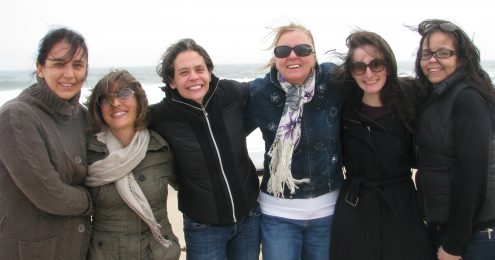Useless meetings? I have had my share. Bet you have too.
Back in my corporate America days I would find myself sitting in meetings that were just a pure waste of time.
Maybe the meeting was poorly led. Or the convener liked to hear herself talk. Or there was no agenda. Or the meeting got awkward for any number of reasons.
Later, as a nonprofit board member, I left board meetings thinking I could have called in, put the phone on mute and checked Facebook. I had learned nothing that I had not read in the written packet.
My technique for dealing with useless meetings? I called it “wood grain analysis.” My technique for disappearing from the room. A nice close look at the patterns and an opportunity to make mental lists about the work I should be doing.
And I’ll confess. I am certainly not immune to this problem here in my consulting shop. I have let staff members drone on (I did not want to hurt their feelings or embarrass them in front of colleagues). I have raced into meetings unprepared to lead it and pulled some agenda out of thin air.
We have all done it.
But during a recent break I discovered the antidote to this syndrome, and I felt compelled to share it with you.
THE WORST, MOST EXPENSIVE, USELESS MEETING I EVER ATTENDED
It was a corporate department retreat. I remember it like it was yesterday but it was actually nearly 20 years ago. Arizona. A group of maybe 100? A five-star resort.
The highlight for me was night golf. Each of us equipped with a headlamp and a cup with a corporate logo. Oh yes, and glow-in-the-dark golf balls.
After each hole, there was a bar and buffet, each with a different theme. By hole three, it didn’t matter if the ball glowed in the dark. It could have been a soccer ball and I would have not have been able to see it.
Frankly, I’m surprised I can even remember this golf expedition. It’s the only thing I remember from the retreat.
I suppose that the conveners would say the purpose was to appreciate our hard work or to build a stronger sense of team. Or maybe to motivate us after presentations about the great work our company was going to do that year.
I do remember thinking that it was horribly ironic for a finance team to spend this kind of money.
I’m not gonna lie. It was fun. Really fun.
I felt appreciated and it was great to have a few days off in the sun during the winter. And I actually do play golf.
But the problem? The planning was about location, not purpose. I went home with a cup with the logo, a few golf ball souvenirs and most definitely stories about how my colleagues (and I) made fools of ourselves. Yes, there was some team building but ‘team building’ is not enough. It has to be in the service of something more. Something meaningful.
Make this the year that you gather with purpose.
THE ART OF GATHERING
Here’s my gift to you as you begin to think about how this year might look different, better, and more productive.
It’s a book. The Art of Gathering by Priya Parker.
It will not take you long to read. As a board chair you need to buy it right now. E.D.? Buy it right now.
And if you have a group of direct reports who have teams, buy it for them right now too. Begin to introduce a new way of thinking about how and why you meet.
This post is intended to whet your appetite about the book, not to let you off the hook from reading it in its entirety. So here are a few key takeaways. Here’s hoping they will intrigue you and lead you to want to know more and make the changes that you and your organizations deserve.
- GATHERINGS MATTER
You will never say, “I wish we didn’t have so many meetings” ever again if you follow what Parker writes. She notes that the freedom to assemble is a foundational right granted to every individual. Why? Because amazing things can happen “when people come together, exchange information, inspire one another and test out new ways of being together.”
- FACILITATORS DON’T JUST DIRECT THE “TRAFFIC.”
I hear this all the time. “Joan, can you facilitate our board retreat. We have the agenda set and we plan to allocate some of the time for a board meeting. You just need to manage the group.”
I turn down these requests because they are just looking for a traffic cop.
Parker articulates the role of a facilitator simply and with remarkable clarity. “My job is to put the right people in a room and help them to collectively think, dream, argue, heal, envision, trust and connect for a larger purpose…. I strive to help people experience a sense of belonging.”
Wow. Bet you never really thought of a facilitator as being that kind of magician.
You will now.
- DON’T MISTAKE A CATEGORY FOR PURPOSE
We do it all the time. We label the gathering and think we are off the hook. The “staff meeting”, the “senior team meeting”, “the board meeting”, “the staff offsite”. Even “the dinner party.” We believe that the name, the category defines the need.
I was coaching a Communications Director, recently promoted to be a member of the senior team of a mid-sized organization. She was puzzled. “I don’t know what it means to be on the senior team. Best I can figure is that I just go to a lot more meetings and I’m getting a lot less done.”
Meetings are convened by these categories and the categories are presumed to define the reason for the meeting.
And don’t get me started by conveners who are unprepared or meetings without agendas.
- ROUTINE IS THE ENEMY OF MEANINGFUL GATHERINGS
Weekly staff meetings. Let’s grab the agenda from last week. Or better yet, ask folks what should be on the agenda.
Or how about board meetings? After a while you just follow what you’ve done. Your reports are the same. And this leads right back to ‘wood grain analysis.’
- CLARITY OF PURPOSE IS THE KEY TO MEANINGFUL GATHERINGS
What do you want from the gathering? What will success look like? Then, as Parker says, ‘reverse engineer’ the design to lead to that outcome. She references a quarterly meeting to discuss how the year is going. But that is not a clear enough purpose. What is? If the purpose is to generate a list of actionable changes you will make in the next quarter as a function of the quarterly results, well, that is an outcome.
- PURPOSE LEADS TO THE RIGHT ‘GUEST’ LIST
Ever hear this? “Why was in that meeting?” Or better still, “I don’t know why they had that meeting without me!” If the convener can explain the desired outcome for the meeting with clarity and specificity, it then becomes wildly clear who should be at the table. And easy to explain why someone is or isn’t at that table.
MEANINGFUL GATHERINGS CAN BE A CRITICAL PATHWAY TO FINDING BALANCE
I credit not Parker, but rather my client and friend Dara Klarfeld, the CEO of DRG Search with this takeaway. Actually, I credit Dara with suggesting that I read this book, so I owe her a big ol’ shout out. She had me at hello when she said, “I am changing how I gather at work and I am approaching my son Harry’s bar mitzvah through a completely different lens.”
Here’s what she said that led me to order the book immediately.
“The book has inspired me to make sure that we are always meeting with purpose, and helps us to better keep track of how to make sure that we have balance in our purpose. The book has inspired us to dramatically change the way we think about how we interact as a team—how to help people to manage their time better, and how to better serve our clients.
BUT, the real value for me in the book was about how intentional gathering can be a critical pathway to finding balance in your life. Intentional gathering gives us a pathway and permission to work hard and smart, celebrate with real meaning and purpose, build relationships in an open and honest way and play without being apologetic.
I just thought the entire idea was brilliant—mostly because it’s right there in front of us, and nobody had really named it yet!”
HOW IT HAS ALTERED MY OWN THINKING ABOUT MY BUSINESS
We have an amazing database filled with contacts, leads, projects, and tasks. This helps us to keep ourselves on track and provide the best services to our nonprofit clients.
But I don’t run my business for the huge thrill of crossing tasks off my to do list. I do this work because I am inspired by my clients, and intrigued and motivated to help them solve problems. My clients give me hope and I believe that in a world that feels pretty broken, I am helping to repair some small pieces of it.
But what about Marge my business manager, or Cindy who runs my business and fields incoming requests? Or my admin or our paid intern who answer incoming email from leaders who are really struggling? How do I ensure that they feel that same sense of meaning and purpose?
And so my own new commitment is a one-hour weekly meeting. It’s not to make sure we are all on task or budget, but rather to bring the work to life.
Lindsay and Dan may be working on something that Trevor is not aware of. He may have an interesting perspective based on what he hears from our blog subscribers. The purpose of this meeting – to connect my team to the work, to bring the work to life, to motivate folks and as a result, to take a smart group of people who may very well add value to how we serve our clients and to generate ideas that could lead to new ways of approaching our work, and supporting and advocating for those we are privileged to work with.
Here’s hoping this book inspires you in a similar way.
Want to learn more about the right way to run meetings?



